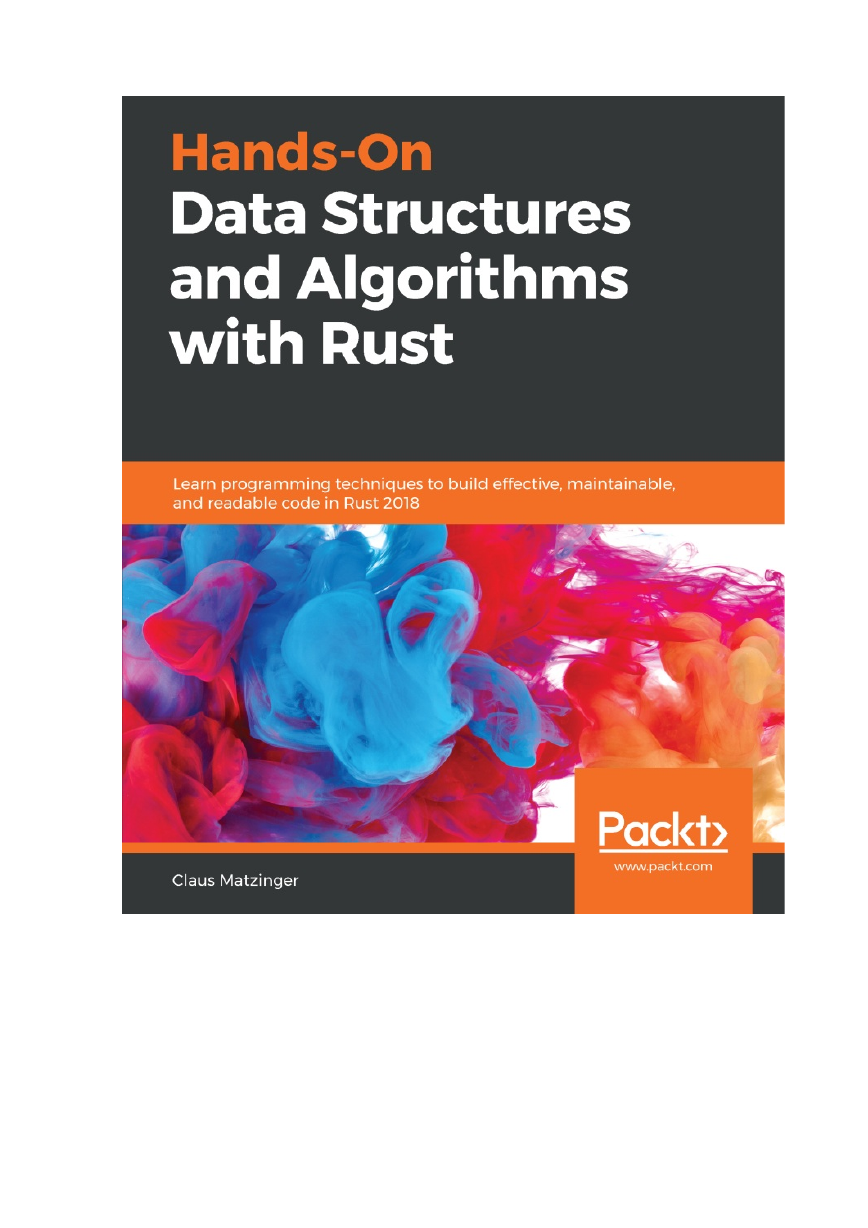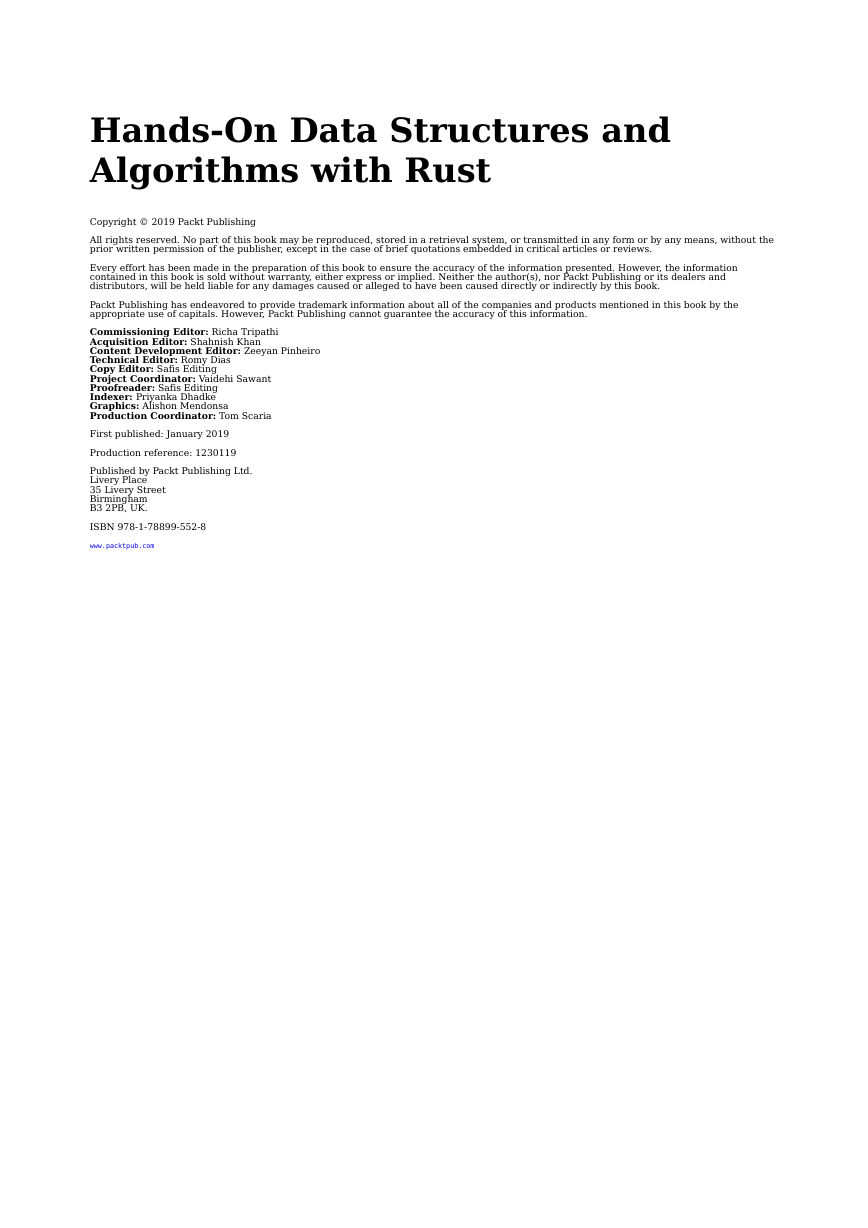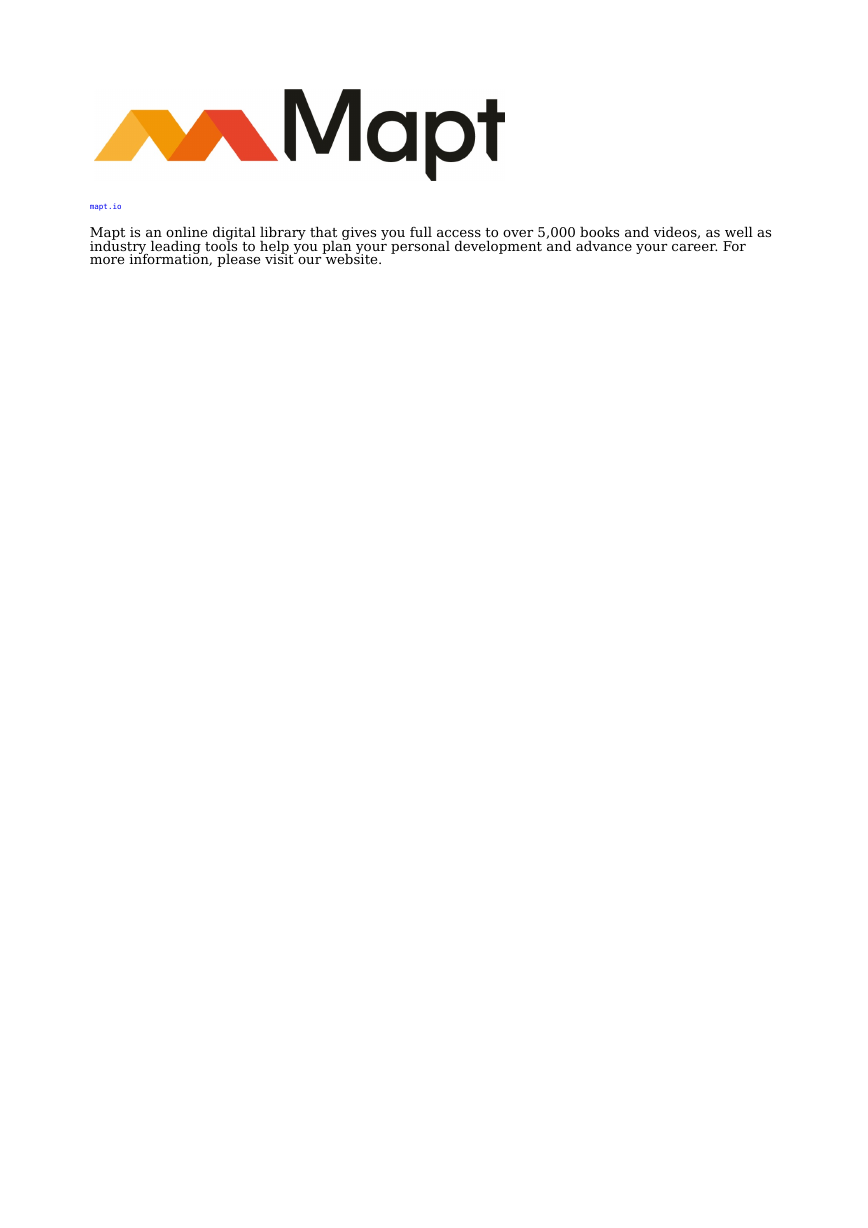�
Hands-On Data Structures and Algorithms with Rust
Learn programming techniques to build effective, maintainable, and readable code in Rust 2018
Claus Matzinger
BIRMINGHAM - MUMBAI
�
Hands-On Data Structures and
Algorithms with Rust
Copyright © 2019 Packt Publishing
All rights reserved. No part of this book may be reproduced, stored in a retrieval system, or transmitted in any form or by any means, without the
prior written permission of the publisher, except in the case of brief quotations embedded in critical articles or reviews.
Every effort has been made in the preparation of this book to ensure the accuracy of the information presented. However, the information
contained in this book is sold without warranty, either express or implied. Neither the author(s), nor Packt Publishing or its dealers and
distributors, will be held liable for any damages caused or alleged to have been caused directly or indirectly by this book.
Packt Publishing has endeavored to provide trademark information about all of the companies and products mentioned in this book by the
appropriate use of capitals. However, Packt Publishing cannot guarantee the accuracy of this information.
Commissioning Editor: Richa Tripathi
Acquisition Editor: Shahnish Khan
Content Development Editor: Zeeyan Pinheiro
Technical Editor: Romy Dias
Copy Editor: Safis Editing
Project Coordinator: Vaidehi Sawant
Proofreader: Safis Editing
Indexer: Priyanka Dhadke
Graphics: Alishon Mendonsa
Production Coordinator: Tom Scaria
First published: January 2019
Production reference: 1230119
Published by Packt Publishing Ltd.
Livery Place
35 Livery Street
Birmingham
B3 2PB, UK.
ISBN 978-1-78899-552-8
www.packtpub.com
�
mapt.io
Mapt is an online digital library that gives you full access to over 5,000 books and videos, as well as
industry leading tools to help you plan your personal development and advance your career. For
more information, please visit our website.
�
Why subscribe?
Spend less time learning and more time coding with practical eBooks and Videos from over
4,000 industry professionals
Improve your learning with Skill Plans built especially for you
Get a free eBook or video every month
Mapt is fully searchable
Copy and paste, print, and bookmark content
�
Packt.com
Did you know that Packt offers eBook versions of every book published, with PDF and ePub files
available? You can upgrade to the eBook version at www.packt.com and as a print book customer, you are
entitled to a discount on the eBook copy. Get in touch with us at customercare@packtpub.com for more details.
At www.packt.com, you can also read a collection of free technical articles, sign up for a range of free
newsletters, and receive exclusive discounts and offers on Packt books and eBooks.
�
Foreword
Rust is not an easy language to learn. Ask why, and you'll hear that Rust was designed to solve
almost any complex problem in system programming, a complicated domain to begin with. It was
designed to do it safely, to be incredibly fast, and be very strict; "ease of use" is a necessary
sacrifice. Rust reads like any other imperative language, but it incorporates a number of special
concepts that ask you to think through your problems in greater depth and with a different spin
than you're used to. It's brutally honest about the complicated parts a system language has to
address.
Those are the typical reasons cited for why Rust is hard. The more honest answer is that those
people may not have the right teacher.
I met Claus at my first event as an open source developer for Microsoft. He had joined just a few
months before, and could show me the ropes. It didn't occur to me until a few weeks later that, as
his manager, I was supposed to be teaching him! I've discovered that this is a common situation for
Claus: he falls naturally into a teaching role. Not a lecturing bore, either—the kind of teaching
where the student doesn't realize that's what's happening until they find themselves using newly
acquired knowledge. We've long since moved into other roles, but I've seen the pattern repeated
over and over again.
Early in his career as an open source developer, Claus found himself diving deep into
documentation. And fair enough: it's often the most important part of a project! "Just three lines,"
he said to me once. "I just lost a whole day of my life because someone didn't bother to write three
lines of good documentation. I can fix that."
Claus's background was in academic software development, but in his professional life, he has
rejected the dry, abstract computer science theory often taught in that environment. He is one of
those rare developers who cares deeply about making this easy for people to understand. It's
important that it makes sense, it's important that it looks nice, it's important that it's easy to follow
—and how to make it that way is intuitive to him. I think it honestly doesn't occur to him that other
people struggle to explain things the way he does naturally.
One of the aspects of this book that I appreciated the most when reading it is the balance Claus
strikes. It stays focused on the teaching goal without getting sidetracked by more technical detail
than is required. We all know the feeling of reading that kind of documentation—the kind that
demands to be skimmed. Most readers, including myself, are simply confused by too much theory or
detail at the outset. As Claus puts it, "most teachers make it sound like something really fancy is
going on, but, in reality, it's quite simple."
This practical approach has made Claus an in-demand speaker, community member, and contributor
in the Rust world. This book is his next step into teaching for a broader audience, and I'm excited to
see its impact.
You've chosen a great teacher! Rust is difficult to learn, but it doesn't have to be. Just ask Claus.
Campbell Vertesi
Principal Software Engineer Manager
twitter: @ohthehugemanatee
ohthehugemanatee.org
�
















 2023年江西萍乡中考道德与法治真题及答案.doc
2023年江西萍乡中考道德与法治真题及答案.doc 2012年重庆南川中考生物真题及答案.doc
2012年重庆南川中考生物真题及答案.doc 2013年江西师范大学地理学综合及文艺理论基础考研真题.doc
2013年江西师范大学地理学综合及文艺理论基础考研真题.doc 2020年四川甘孜小升初语文真题及答案I卷.doc
2020年四川甘孜小升初语文真题及答案I卷.doc 2020年注册岩土工程师专业基础考试真题及答案.doc
2020年注册岩土工程师专业基础考试真题及答案.doc 2023-2024学年福建省厦门市九年级上学期数学月考试题及答案.doc
2023-2024学年福建省厦门市九年级上学期数学月考试题及答案.doc 2021-2022学年辽宁省沈阳市大东区九年级上学期语文期末试题及答案.doc
2021-2022学年辽宁省沈阳市大东区九年级上学期语文期末试题及答案.doc 2022-2023学年北京东城区初三第一学期物理期末试卷及答案.doc
2022-2023学年北京东城区初三第一学期物理期末试卷及答案.doc 2018上半年江西教师资格初中地理学科知识与教学能力真题及答案.doc
2018上半年江西教师资格初中地理学科知识与教学能力真题及答案.doc 2012年河北国家公务员申论考试真题及答案-省级.doc
2012年河北国家公务员申论考试真题及答案-省级.doc 2020-2021学年江苏省扬州市江都区邵樊片九年级上学期数学第一次质量检测试题及答案.doc
2020-2021学年江苏省扬州市江都区邵樊片九年级上学期数学第一次质量检测试题及答案.doc 2022下半年黑龙江教师资格证中学综合素质真题及答案.doc
2022下半年黑龙江教师资格证中学综合素质真题及答案.doc